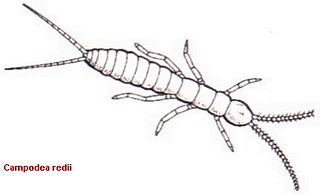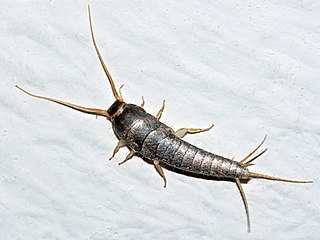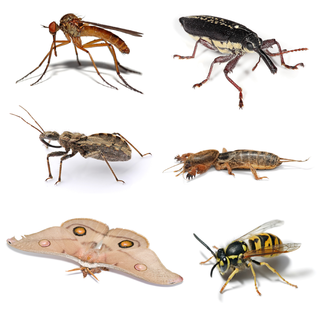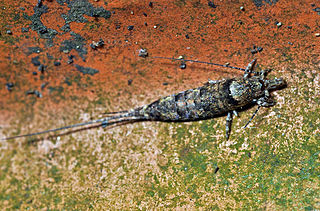
The Campodeidae are a family of hexapods belonging to the order Diplura. These pale, eyeless hexapods, the largest of which grow to around 12 mm in length, can be recognised by the two long, many-segmented cerci at the end of the abdomen. Abdominal spiracles are absent.

A silverfish is a small, wingless insect in the order Zygentoma. Its common name derives from the animal's silvery light grey colour, combined with the fish-like appearance of its movements. However, the scientific name, indicates the silverfish's diet consists of carbohydrates such as sugar or starches.

The Dicondylia are a taxonomic group (taxon) that includes all insects except the jumping bristletails (Archaeognatha). Dicondylia have a mandible attached with two hinges to the head capsule (dicondyl), in contrast to the original mandible with a single ball joint (monocondyl).
Allopsontus is a genus of the family Machilidae which belongs to the insect order Archaeognatha. Certain species in this genus have been found as high as 5 kilometres above sea level on the Himalayas.
Charimachilis is a genus of the family Machilidae which belongs to the insect order Archaeognatha. They are found in southern and eastern Europe.
Meiocampa is a genus of two-pronged bristletails in the family Campodeidae. There are about five described species in Meiocampa.
Metriocampa is a genus of two-pronged bristletails in the family Campodeidae. There are about six described species in Metriocampa.
Podocampa is a genus of two-pronged bristletails in the family Campodeidae. There are about 18 described species in Podocampa.
Haplocampa is a genus of two-pronged bristletails in the family Campodeidae. There are at least four described species in Haplocampa.
Machilinus is a genus of rock bristletails in the family Meinertellidae. There are about 17 described species in Machilinus.

Machiloides is a genus of rock bristletails in the family Meinertellidae. There are at least two described species in Machiloides.
Mesomachilis is a genus of jumping bristletails in the family Machilidae. There are about six described species in Mesomachilis.
Petridiobius is a genus of jumping bristletails in the family Machilidae. There are at least two described species in Petridiobius.

Trigoniophthalmus is a genus of jumping bristletails in the family Machilidae. There are about 11 described species in Trigoniophthalmus.

Machiloides banksi is a species of rock bristletail, family of basal insects belonging to the order Archaeognatha, in the genus Machiloides.
Campodeinae is a subfamily of two-pronged bristletails in the family Campodeidae. There are about 12 genera and at least 70 described species in Campodeinae.
Petridiobius arcticus is a species of jumping bristletail in the family Machilidae. It is found in Europe & Northern Asia and North America.






